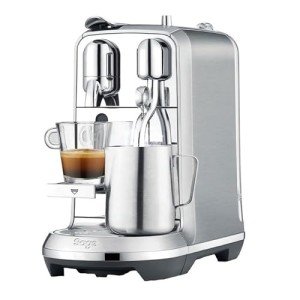10 Real Reasons People Hate Heat Exchange Espresso Machines

Heat Exchange Espresso Machines: A Comprehensive Guide
Espresso machines have developed significantly for many years, accommodating the needs of home baristas and coffee professionals alike. Amongst these machines, heat exchange espresso machines have acquired popularity due to their capability to provide constant performance and remarkable brew quality. In this short article, we will explore the workings, benefits, and crucial functions of heat exchange espresso machines, offering a detailed understanding for both potential purchasers and coffee lovers.
Understanding Heat Exchange Technology
Heat exchange espresso machines operate on an unique principle that enables synchronised water heating for brewing and steaming. They are equipped with a single boiler that uses a heat exchanger system. This feature is significant as it enables users to brew espresso while steaming milk concurrently, promoting effectiveness in the coffee-making procedure.
How Does a Heat Exchange Espresso Machine Work?
The procedure starts with the machine's water inlet filling the boiler. As the water warms up, it turns to steam. The ingenious heat exchanger utilizes hot steam to heat extra water in a different passage designed specifically for the brew group. This implies that water can reach the ideal brewing temperature without awaiting the boiler to change. The essential steps include:
- Water Fill: Water is drawn into the boiler.
- Heating Process: The boiler heats up as water is transformed into steam.
- Heat Exchange: Steam warms water in the heat exchanger tube.
- Brewing: Water from the heat exchanger is pushed through coffee premises, extracting the flavors required for an abundant espresso.
This procedure permits quick temperature modifications and improved coffee extraction.
Benefits of Heat Exchange Espresso Machines
Heat exchange espresso machines provide a number of advantages, particularly for those aiming to optimize their coffee experience. Here are some key benefits:
- Simultaneous Brewing and Steaming: Users can brew espresso while steaming milk, making it ideal for busy coffee shops and home baristas who value effectiveness.
- Temperature level Stability: The boiler's steam pressure assists maintain a stable temperature level, which is crucial for constant espresso extraction.
- Flexibility: The design allows for quick switching in between developing and steaming, making it much easier to create different coffee beverages, from lattes to cappuccinos.
- User-friendly: Models typically include available controls, making it possible for both novices and experienced baristas to produce quality drinks.
- Professional Quality: Heat exchange machines are frequently utilized in commercial settings, providing users with high-quality developing efficiency in the house.
Secret Features to Look for in Heat Exchange Espresso Machines
When considering the purchase of a heat exchange espresso machine, there are a number of features that one must consider:
- Build Quality: Look for machines made from long lasting products, such as stainless steel or brass, guaranteeing longevity.
- Boiler Size: A larger boiler will hold more water and sustain higher output in time.
- PID Temperature Control: This feature helps maintain constant brew temperatures, which can enhance the coffee-making process.
- Group Head Design: Machines with a saturated or semi-saturated group head offer much better temperature stability.
- Reduce of Use: User-friendly interfaces and user-friendly controls enhance the general experience for baristas at all ability levels.
- Steam Wand Quality: A great steam wand with appropriate insulation and versatility allows for much better texturing of milk.
- Water Reservoir Size: Depending on your needs, consider how often you desire to refill the water reservoir.
Comparison of Popular Heat Exchange Espresso Machines
To much better comprehend the choices available in the market, below is a comparison table of some popular heat exchange espresso machines:
| Machine Model | Boiler Size | PID Control | Rate Range | User Ratings |
|---|---|---|---|---|
| Profitec Pro 700 | 2.0 L | Yes | ₤ 2,000-₤ 2,500 | 9.5/ 10 |
| Rocket Espresso R58 | 1.8 L | Yes | ₤ 2,400-₤ 2,800 | 9.4/ 10 |
| Elekta Bianca | 1.8 L | Yes | ₤ 2,500-₤ 3,000 | 9.6/ 10 |
| La Spaziale S1 Vivaldi II | 1.5 L | Yes | ₤ 1,800-₤ 2,200 | 9.2/ 10 |
| Bezzera Magica | 1.2 L | No | ₤ 1,600-₤ 1,800 | 9.0/ 10 |
FAQs About Heat Exchange Espresso Machines
What is the primary distinction in between a heat exchange and a dual boiler espresso machine?
While both types can brew espresso and steam milk at the very same time, dual boiler machines have different boilers for developing and steaming. On the other hand, heat exchange machines make use of a single boiler and a heat exchanger to accomplish the exact same function.
Are heat exchange machines suitable for novices?
Yes! Numerous heat exchange machines are developed with easy to use features, making them accessible for beginners. With appropriate assistance and practice, users can rapidly produce quality espresso.
What type of maintenance do heat exchange espresso machines require?
Routine maintenance includes descaling, cleaning the boiler, checking seals and gaskets, and keeping the group head tidy. coffeee.uk guarantees durability and constant performance.
Can I use a heat exchange machine for various types of coffee drinks?
Definitely! Heat exchange machines allow users to develop a variety of coffee beverages, including espresso, lattes, cappuccinos, and more.
Heat exchange espresso machines represent a blend of innovation and custom, offering coffee lovers with the tools required for crafting the perfect cup. Their capability to concurrently brew and steam, integrated with accurate temperature level control, makes them a compelling option for both home baristas and professionals. With the best understanding on features and maintenance, users can open a world of beautiful coffee experiences, ensuring that each sip is as wonderful as the last.

